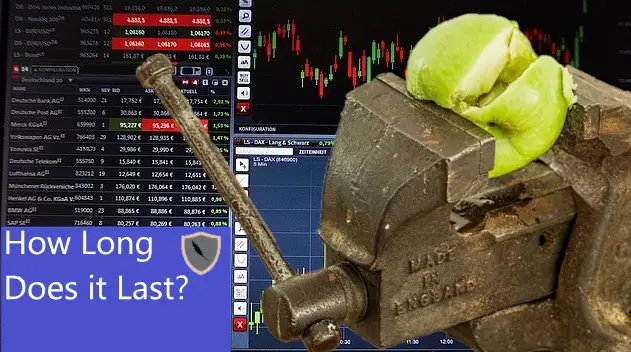A stock split is an opportunity. There is going to be increased volatility and those who are caught unaware could see massive losses. However, those who know what to do could come out on top and make some nice profit. I am going to show you the pros and cons of stock splits so that you and your portfolio will be protected.
Here at Chronohistoria I teach people how to generate above normal market returns in their investments. I routinely publish articles on investment research, methodologies, and tips/tricks. There is a free newsletter that you can sign up for to remain up to date if you want.
Without wasting any time let’s jump right into the article; Stock Splits: The Pros and Cons You Need To Be Aware Of.
What Is A Stock Split?
Ok, so we first need to define what a stock split is.
A stock split is when a publicly traded company decides to increase or decrease its current amount of shares to manipulate the price value legally. For example a stock split can be done to take the average price of a stock from $1,000 down to $100. Companies would do this to make their shares more affordable for individual investors. (Source on definition)
The good news about a stock split is that when it happens it won’t directly impact your portfolio. This is because if you already hold shares of a company that announces a stock split they will compensate your position in their stock accordingly. This is done to make sure that your percentage of ownership remains the same.
For example, if you own 100 shares of a company that trades at $1,000 a share your total position is $100,000. Now that same company issues a stock split at a 5 for 1 ratio in an effort to lower their share price from $1,000 down to $200. Before this happened you owned 100 shares at $1,000 each ($100,000) now with the stock split you now own 500 shares at $200 each ($100,000).
Generally speaking a stock split is a good sign that a company wants to attract more investors. Some big names have undergone stock splits recently such as TSLA, NVDA, and NEE in the hopes to attract more and more investors to their stock.
What Are The Pros?
Stock splits end up having several pros that can impact your portfolio in a good way. The trick is to understand when the stock split is happening and how you can best benefit from them.
There are 3 pros to the stock split.
Pro 1: Retail Trader Pump
When a company announces a stock split, typically investors flock to buy the company. This is because a stock split signals to the market that the company is either going to be rapidly expanding or unveiling a new product.
The company issuing the stock split wants to attract more investors who would rather be willing to pay $100 instead of $1000 a share. A stock split in this case can be seen as a strategic move performed by upper level management who are expecting a rapid influx of attention to their public stock.
In 2002 an article was published in the journal of financial research titled “Intra-Industry Reactions to Stock Split Announcements.” This article looked at how the markets looked at entire sectors and reacted to an announced stock split. What the researchers found was astounding, retail traders would pour into a stock in droves. All risk models and expected ROI were thrown out the window as the split stock shot up in volatility. (Source for article)
Simply put, when a stock split happens you will notice more retail investors buying the stock.
Pro 2: Increased Float And Lower Volatility
When a company performs a stock split they will increase the total amount of shares available for trade. This increase in total shares means that it will take more ‘movement’ to push the stock up or down.
The total amount of shares on the stock market that retail investors can buy or sell is called the float. It’s called this because the shares can ‘float’ between public investors accounts. If a company has only 40 million shares in their float that’s an indication of a highly volatile stock. On the other hand if a company has 4 billion shares in their float its a very stable stock.
In this case a stock split over the long term indicates that the stock is expected to grow steadily. A stock split in this case is indicating to potential investors that the company wants to lower their overall price swings and have a conservative growth. This is a good sign for investors who want to just invest and forget about their money.
A stock split here is going to increase the total float which in turn is going to lower implied volatility. Here is a great article written in The Singapore Economic Review that goes over price speculation (volatility) in regards to float and stock splits. (Click here for article)
Pro 3: Increased Liquidity
Liquidity is what drives the global market economy. When a stock undergoes a stock split more retail investors begin to buy the stock, which means that liquidity begins to increase as well.
If you’re looking to take a larger position in a company but can’t because of liquidity concerns then a stock split is a saving grace that will give you the ability to generate more returns.
Most people completely forget about this and don’t take advantage of the increased liquidity that comes during a stock split. In fact you can build an entire investment portfolio methodology that only makes money off the liquidity jumps that take place during stock splits. (Here is an article that goes over the stock split liquidity jump)
For the average investor however if you know what your doing you can make a pretty decent return (around 18% in one month) if you know how to run iron condors during a liquidity spike. (Here is an article I wrote on the Iron Condor Strategy)
What Are The Cons?
Stock Splits are not without their cons. If you don’t understand the current state of the market and the company then the stock split can actually hurt your portfolio. This is because the volume jump that happens during a stock split can lead to panic if you’re not aware of it.
There are 2 cons to the stock split.
Con 1: Increased Volatility During Split
If you’re not prepared for the stock split announcement and don’t understand what you are doing you could see huge losses in your portfolio. This is because during a stock split there is a period of much higher volatility that drives prices crazy.
As we can see from the above graph in month 6 a stock split was announced. This caused a massive increase in price volatility (from 30% up to around 90%) as more and more people bought into the stock. This caused both algorithmic trading and investors to go crazy and push the stock’s price up and down.
However most of the time a stock split is a good sign and this increase in volatility will eventually dive back down to normal (30% for the above graph). At this point the stock will return to its normal daily motion.
If you were not aware of this increase in volatility during the stock split then you might sell out of fear and miss out on future rewards. The trick here is to weather the storm and wait for the volatility to climb back down to its background level. (Here is an article that goes over how waiting out volatility can lead to large returns)
Con 2: Increased Institutional Investors
When a stock increases in total amount of shares on the market (float) then you will notice a higher amount of institutional investors buying into the stock split.
Large institutional investors can directly impact your investment. They can influence board meetings and corporate actions with their large investments. These types of institutions are called activist funds. If your now aware of their actions you could lose a lot.
It’s best to be aware of these big fish. A great example of a stock split leading to an activist takeover can be seen with Elliot Management buying out Barnes and Noble for $683 million in 2019 and taking it private. (Source)
The trick with this con is to simply be aware of what 13f reports are and read them. A 13f report simply alerts retail investors that a large fish has entered into their investment. A great source to read up on 13f investors and their activities is the website WhaleWisdom. I recommend giving them a look through to see what’s going on in your investment.
Conclusion
There you have it, the pros and cons of a stock split. Just by arming yourself with this knowledge you can earn substantially more in the stock market. It’s important to remember that most stock splits are good signs and not to panic during the high volatility.
Several large companies in the past have undergone several stock splits to lower their share price to average consumer level. It’s nothing to be afraid of. If you know what to do you can earn a lot by investing at the right time.
Here at Chronohistoria I teach people how to generate above normal market returns in investments. Feel free to sign up for the free newsletter to remain up to date on everything investing.
Further, you can check out some of the other articles below.
-
How Long Does a Short Squeeze Last? (3 Answers)

What is the time frame for you short squeeze? Well here is everything you will ever need to know to determine how long it will last.
-
Why You Still Own a Stock After It’s Delisted and How to Sell It

Do you still own a stock after its delisted? How do you sell it? Don’t worry the stock is still worth money and here is how to sell.
-
Can You Make 1% A Day in the Stock Market? (3 Steps)

Making 1% a day in the stock market is hard but defiantly doable. Here are 3 simple steps to helping you achieve this return.
Until next time, I wish you the best of luck in your investing journey.
Sincerely,



